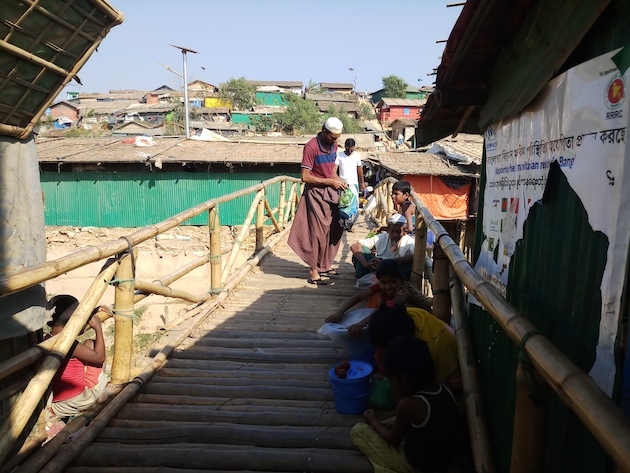DHAKA, Jun 27 (IPS) – With the monsoon in Bangladesh, Rohingya refugee camps in Cox’s Bazar have emerged as a dengue hotspot, with the mosquito-borne disease continuing to spread among the stateless refugees.
“A total of 1,066 dengue cases were reported in highly cramped refugee camps in Cox’s Bazar up to May 23 this year, while the case tally was only 426 among the local community there,” Dr Nazmul Islam, Director of Disease Control and Line of the Directorate General of Health Services (DGHS), said.
However, the latest data of the DGHS revealed that 1,283 people were infected with and 26 people died of dengue in the Rohingya camps and surrounding host community in Ukhiya and Teknaf upazilas of Cox’s Bazar from January 1 to June 6, 2023.
Nazmul said the dengue infection rate is highest in the Rohingya camps.
“Rohingya camps in Cox’s Bazar have the highest number of dengue patients. Last year, over 17,000 dengue patients were identified there. The number of dengue patients is so high this year, too,” he said.
Official data showed that dengue cases increased significantly in 2022 when the monsoon started. Experts fear the dengue situation will be more acute in the Rohingya camps during the monsoon this year.
Bangladesh witnessed its largest influx of Rohingya refugees in 2017 following a military crackdown in the Rakhine State of Myanmar. According to UNHCR, about 7,73,972 Rohingya people entered the country as refugees, totaling nearly 10 million with the previous influxes.
The forcibly displaced Rohingyas took shelter in overcrowded makeshift camps where they lacked access to civic amenities, including education, food, clean water, and proper sanitation, and also face natural disasters and infectious disease transmission.
“Most refugees have no adequate access to clean water, sanitary facilities, or healthcare. The monsoon season also poses a huge threat to thousands of Rohingya families living in makeshift shelters as dengue outbreak emerges in camps during the period,” said Ro Arfat, a Rohingya refugee.
Nazmul said Rohingya refugees live in a limited space in the camps where there is not enough scope to runoff rainwater, so stagnant water creates an enabling environment for the breeding Aedes mosquito, carrier of the dengue virus.
He said the risk of dengue infections climbs in densely populated areas. With the monsoon, the dengue situation could turn dangerous in the refugee camps.
Dr Iqbal Kabir, Professor and Director at the Climate Change and Health Promotion Unit, the Ministry of Health, Bangladesh, said in recent years, environmental changes have been markedly observed throughout the globe, and there is no exception in Bangladesh.
“The nature of the Aedes mosquito is that it must bite five humans to suck blood as per its demand, and an Aedes mosquito lays more than 200 eggs a time. Once they get suitable humidity and temperature, mosquito breeding occurs,” Kabir said.
He observed that dengue spreads very fast, but the authorities have not controlled dengue infections in the highly-crowded refugee camps in Cox’s Bazar.
During the monsoon, Bangladesh experiences spikes in dengue outbreaks. In 2022, 17 refugees died from dengue infections in Rohingya camps.
Despite having a high dengue infection rate in the camps, lack of awareness about the virus and the absence of prompt diagnosis of the disease make the Rohingya refugees more vulnerable.
“An Aedes mosquito can infect many within seconds, and keeping densely populated refugee camps safe from mosquitoes is really difficult. So there is a high possibility of a severe outbreak in the refugee camps,” said Mahbubur Rahman, Civil Surgeon, and Chief Health Officer for Cox’s Bazar.
Urgent Action Needed
The burden of dengue is related to the changes in rainfall patterns. The rainfall pattern has been changed. Pre-monsoon erratic rainfall is linked with the increase of vectors.
Unusual rainfall occurred in Cox’s Bazar area earlier this year, triggering dengue outbreaks in the camps.
Kabir said the dengue national guideline should be revisited to check dengue outbreaks across the country, including Rohingya camps.
He suggested launching a crash programme to prevent dengue infections in Rohingya camps; if clustering could be ensured, it would be easy to deal with the dengue situation there.
Golam Rabbani, head of BRAC’s Climate Bridge Fund, said the Bangladesh government should initiate research and increase the authorities’ capacity to tackle any future outbreak of dengue in the country.
He says the Department of Public Health and the DGHS should identify dengue as one of the most climate-sensitive diseases and improve their disease profile, suggesting the government initiate investment and policy interventions to address the dengue in Bangladesh.
IPS UN Bureau Report
Follow @IPSNewsUNBureau
Follow IPS News UN Bureau on Instagram
© Inter Press Service (2023) — All Rights ReservedOriginal source: Inter Press Service
Check out our Latest News and Follow us at Facebook
Original Source

